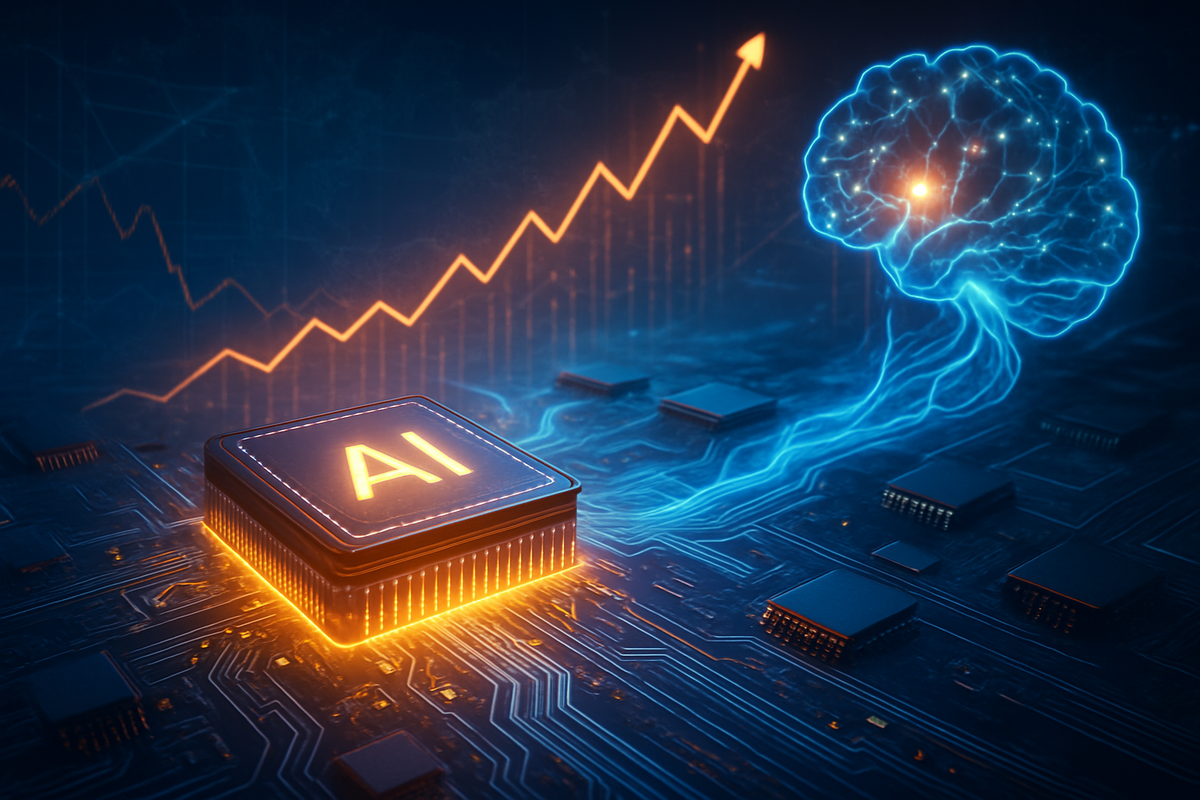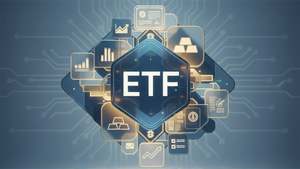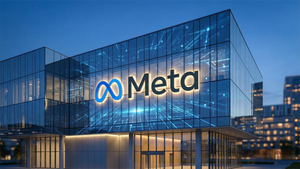
The interplay between artificial intelligence (AI) and the semiconductor industry has become the defining technological narrative of our time, creating a symbiotic relationship that is not only driving unprecedented demand for advanced chips but also fundamentally influencing the future trajectory of semiconductor development. As of October 1, 2025, the relentless pursuit of more powerful, efficient, and specialized AI capabilities has propelled the global semiconductor market into an era of explosive growth, positioning it at the core of the digital economy's evolution. This dynamic partnership is fostering a virtuous cycle where advancements in AI necessitate increasingly sophisticated silicon, while AI itself becomes an indispensable tool for designing and manufacturing these next-generation processors, promising to reshape industries and economies for decades to come.
The AI Gold Rush: Unprecedented Demand and Strategic Maneuvers
The current AI semiconductor boom is characterized by an insatiable hunger for computational power, primarily driven by the proliferation of generative AI, high-performance computing (HPC), and the burgeoning field of edge AI. This surge has led to a flurry of strategic moves, product launches, and massive capacity expansions among the industry's titans. The global semiconductor market is projected to reach approximately $800 billion in 2025, an almost 18% increase from 2024, with AI chips accounting for a substantial portion of this growth. Data centers, in particular, are the primary engine of this transformation, with compute semiconductors for this segment projected to grow by 36% in 2025.
Leading the charge is NVIDIA (NASDAQ: NVDA), which continues to be the undisputed leader in the AI semiconductor space. By early October 2025, its market capitalization had soared past $4.5 trillion, with its GPUs proving indispensable for AI model training and data centers, commanding an estimated 70% of new AI data center spending. NVIDIA's strategic partnerships are equally impactful, including an equity stake of up to $100 billion in OpenAI and a collaboration on the $500 billion "Stargate" project to build five new AI facilities. The company also secured a $14.2 billion deal to supply computing services to Meta Platforms (NASDAQ: META) through CoreWeave. NVIDIA's latest Blackwell platform is a primary growth driver through 2025, with demand exceeding supply, and its shares have surged about 39% in 2025.
Intel (NASDAQ: INTC) is aggressively advancing its Gaudi AI accelerators, with the Gaudi 3 offering PCIe and rack-scale system options. While generally lagging behind NVIDIA's and AMD's top offerings in overall performance, Intel is building an ecosystem with partners like Adobe, Ansys, and Siemens, and its Gaudi 3 is set to launch on IBM Cloud (NYSE: IBM) in early 2025. Intel is also making progress on its 18A process technology, with volume production expected in the second half of FY25, aiming to re-establish its foundry leadership.
Advanced Micro Devices (NASDAQ: AMD) is making a strong push into the AI accelerator market with its Instinct MI350 series GPUs, boasting significant improvements in HBM3E memory and AI compute tasks. AMD projected robust Q3 2025 revenue of approximately $8.7 billion, a 28% year-over-year increase, primarily driven by the ramp-up of its MI350 series. The company anticipates $9.5 billion in AI-related revenue for 2025, and its shares have climbed over 40% in 2025, outperforming the benchmark chip index.
Taiwan Semiconductor Manufacturing Company (NYSE: TSM) remains a critical and foundational player, dominating the advanced chip manufacturing landscape. It widened its lead over Samsung (KRX: 005930) as the world's biggest semiconductor foundry in Q2 2025. TSMC is aggressively pursuing its roadmap for next-generation nodes, with mass production of 2nm chips planned for Q4 2025, and significantly expanding its CoWoS (Chip-on-Wafer-on-Substrate) advanced packaging capacity, which is fully booked until 2025. AI-related applications accounted for a substantial 60% of TSMC's Q2 2025 revenue.
Samsung (KRX: 005930) is intensely focused on High Bandwidth Memory (HBM) for AI chips, accelerating its HBM4 development for completion by the second half of 2025. While Samsung lagged SK Hynix (KRX: 000660) and Micron Technology (NASDAQ: MU) in HBM market share in Q2 2025, it is projected to surpass 30% in 2026, contingent on its HBM4 entering NVIDIA's supply chain. Samsung is also collaborating with TSMC on buffer-less HBM4 chips.
Initial market reactions reflect an overall surge in the AI and technology sector, propelling major indices to record highs. The demand for AI-driven semiconductors is skyrocketing, leading to tight constraints in certain areas of the supply chain, particularly for advanced packaging technologies and HBM chips. There's a clear shift from consumer-driven semiconductor growth to one primarily fueled by the relentless appetite for AI data center chips. Furthermore, major hyperscalers are increasingly developing custom AI chips to optimize their cloud services and reduce reliance on third-party suppliers, a trend underscored by OpenAI's substantial $10 billion order for custom AI chips from Broadcom (NASDAQ: AVGO), to be fabricated by TSMC.
The Shifting Fortunes: Winners and Challengers in the AI Era
The AI semiconductor boom is creating a clear delineation between companies poised for significant gains and those facing substantial challenges or needing to adapt strategically.
NVIDIA (NASDAQ: NVDA) is undeniably a primary winner, solidifying its position as the AI hardware kingpin. Its financial performance is robust, with record revenues driven by its Data Center segment, and its Blackwell AI chips are completely sold out for 2025. The company's comprehensive CUDA software platform further entrenches its ecosystem, making it difficult for competitors to dislodge.
Taiwan Semiconductor Manufacturing Company (NYSE: TSM) is another clear winner, as it is the critical manufacturing partner for virtually all leading AI chip designers. Its aggressive expansion of advanced node capacity (2nm, 1.4nm) and advanced packaging (CoWoS) ensures it captures a significant portion of the value created by AI chip demand. AI-related applications now account for 60% of its revenue, highlighting its central role.
Broadcom (NASDAQ: AVGO) is emerging as a strong contender in the custom AI chip market, securing significant orders from hyperscalers like OpenAI. Its Q3 2025 AI revenue surged by 63% year-over-year, and it projects continued growth, positioning itself as a strong second player after NVIDIA. Beyond chips, Broadcom's advanced networking solutions are crucial for AI data centers.
Advanced Micro Devices (NASDAQ: AMD) is successfully carving out a significant niche, with its Instinct GPUs challenging NVIDIA and its EPYC server processors gaining market share. Its dual-play strategy in both CPUs and GPUs is proving effective, leading to record revenues and strong AI-related revenue projections for 2025.
Marvell Technology (NASDAQ: MRVL) is capitalizing on the AI boom through its custom silicon solutions for data centers and networking. Its data center revenue surged by 98% year-over-year in Q3 FY2025, and analysts project its AI chip sales to double in 2025. Marvell is strategically investing in R&D for custom silicon and high-performance networking chips for hyperscalers.
Conversely, Intel (NASDAQ: INTC) faces a more mixed outlook. While it is making strategic moves with its Gaudi accelerators and focusing on AI-enabled PCs, it significantly trails NVIDIA in the high-end AI accelerator market. Its foundry business (Intel Foundry Services) presents a long-term opportunity if its 18A process can successfully manufacture AI-related chips for others, but it's currently playing catch-up.
Samsung (KRX: 005930) also presents a mixed picture. While benefiting from strong memory demand, especially as its HBM3E chips gain NVIDIA's approval, its foundry business has faced challenges and lost ground to TSMC and SK Hynix (KRX: 000660) in HBM market share. Samsung is fighting back with aggressive pricing for its 2nm chips and strategic investments in AI chip startups, but competition remains intense.
The overall market trend indicates that companies with strong intellectual property in AI-specific architectures, advanced manufacturing capabilities, and integrated hardware-software ecosystems are best positioned to win. Those reliant on older technologies or slower to adapt to the specialized demands of AI will face increasing pressure.
A New Global Race: Wider Significance and Geopolitical Ripples
The AI semiconductor boom is more than just a technological advancement; it's a geopolitical flashpoint, an economic accelerant, and a catalyst for profound industry restructuring. This event fits into broader trends of digital transformation, but with an intensity and strategic importance that sets it apart.
The demand for advanced chips, particularly 2nm technology and advanced packaging, is reshaping the entire semiconductor ecosystem. High-Bandwidth Memory (HBM) is seeing a surge, with its market revenue expected to reach $21 billion in 2025, a 70% year-over-year increase, underscoring its critical role in AI accelerators. Beyond data centers, AI's influence is rapidly expanding into consumer electronics, with AI-enabled PCs expected to make up 43% of all shipments by the end of 2025. This pervasive integration signifies AI becoming a fundamental layer of modern technology.
The ripple effects are vast. Competitors are forced into aggressive R&D and strategic partnerships to keep pace. Hyperscalers are not just consumers but active developers of custom silicon, signaling a shift in the value chain. Traditional sectors, especially those with heavy exposure to automotive and industrial markets, are experiencing a slowdown, indicating a reallocation of capital towards AI infrastructure. The intense energy consumption of AI data centers is also a growing concern, pushing for innovations in energy-efficient designs.
Perhaps the most significant wider implication lies in the geopolitical arena. Semiconductors are now unequivocally strategic assets, fueling an escalating tech rivalry between the U.S. and China. The U.S. has imposed strict export controls on advanced AI chips to China, aiming to curb China's access to critical computing power for AI development and military modernization. These controls have forced companies like NVIDIA to create downgraded versions of their chips for the Chinese market and have impacted the ability of companies like TSMC to freely ship chipmaking equipment to its fab in Nanjing. While there have been signs of easing under the Trump administration, the underlying tension and desire for technological supremacy remain. China, in turn, is responding with domestic substitution policies and restrictions on certain materials, fostering a fractured global supply chain.
This dynamic has led to a global push for supply chain security and resilience. Countries and regions, including the U.S. with its CHIPS and Science Act and the EU with its European Chips Act, are investing billions in domestic manufacturing capabilities to reduce dependency on East Asia. Companies are shifting from just-in-time to "just-in-case" inventory models and adopting multi-sourcing strategies.
Historically, this era draws parallels to the dot-com boom of the late 1990s, with immense investor imagination and speculative excesses, raising concerns about an "AI bubble." However, many argue that the current boom is backed by tangible demand from profitable tech giants, making it fundamentally different. Comparisons can also be made to the Cold War-era tech rivalry between the U.S. and the Soviet Union, highlighting the persistent link between technology leadership and geopolitical influence. The current techno-nationalism reflects similar strategic recalibrations, making the AI semiconductor race a defining contest of the 21st century.
The Road Ahead: Navigating Opportunities and Challenges
As of October 1, 2025, the AI semiconductor market is poised for continued, transformative growth, signaling an infrastructural overhaul rather than a fleeting trend. Both short-term (2025-2030) and long-term (2030-2035 and beyond) possibilities point to a sustained era of innovation and expansion.
In the short term, data centers and cloud computing will remain the primary engines of demand for high-performance GPUs, HBM, and advanced memory. The automotive sector is also expected to be the fastest-growing segment, driven by ADAS and EVs, while 5G and IoT expansion will further fuel demand for specialized chips. A significant refresh cycle in consumer electronics, propelled by AI-driven upgrades and on-device AI integration, is also anticipated.
Looking further ahead, the overall semiconductor industry is on track to become a trillion-dollar market by 2030, with the AI chip market alone potentially reaching over $400 billion by 2030 and even higher by 2035. This suggests an extended AI infrastructure cycle, potentially lasting 10 to 15 years. The future will see continued innovation in chip architectures, including the convergence of x86 and ARM with specialized GPUs, the rise of open-source RISC-V processors, and the exploration of advanced concepts like quantum AI chips and neuromorphic computing.
To thrive, companies must strategically pivot. They are transforming into "AI infrastructure contractors," offering comprehensive ecosystems of hardware and software. The trend of major cloud providers developing custom AI chips (ASICs) will continue, posing a challenge but also creating opportunities for specialized foundry services. Energy efficiency will become a core design imperative due to escalating power demands. Companies must also diversify, offer integrated hardware-software solutions, and leverage AI in their own chip design and manufacturing processes. Supply chain resilience and regionalization will be paramount, driven by geopolitical tensions.
Emerging market opportunities include the rapid expansion of edge AI, specialized AI processors for specific tasks, and the long-term potential of quantum AI chips. "Sovereign AI," where governments invest in domestic AI capabilities for national security and economic interests, is also creating a new multi-trillion-dollar market. However, significant challenges persist, including ongoing geopolitical tensions and export controls, persistent talent shortages, high investment and operational costs, and the risk of market concentration. The need for advanced cooling technology due to increasing chip density and power consumption also presents both an opportunity and a challenge.
The most likely scenario for the industry is continued AI-driven growth dominance, fundamentally reshaping market dynamics and value chains. This will accelerate innovation and foster intense competition, leading to a diverse range of specialized AI hardware solutions. Fragmented supply chains and a greater regional focus are also expected outcomes, driven by geopolitical pressures. While NVIDIA currently holds a strong lead, the rise of custom AI chips and competition from AMD and Intel could gradually shift market shares. Ultimately, sustainability, particularly energy efficiency, will become a core imperative, and the "gold rush" era of massive AI infrastructure investment will continue to define tech and financial markets for the foreseeable future.
Conclusion: A Transformative Era for Semiconductors and Beyond
The symbiotic relationship between AI and semiconductors has ushered in a transformative era, fundamentally reshaping the technological and economic landscape. The key takeaway is the unprecedented and accelerating demand for advanced, specialized chips, driven by the pervasive adoption of AI across all sectors, from hyperscale data centers to consumer devices. This demand has not only propelled industry leaders like NVIDIA (NASDAQ: NVDA) and TSMC (NYSE: TSM) to new heights but has also ignited fierce competition and innovation across the entire supply chain.
Moving forward, the market is characterized by a relentless pursuit of performance and efficiency. Investors should watch for continued advancements in High-Bandwidth Memory (HBM), advanced packaging technologies like CoWoS, and the rapid progression of sub-2nm process nodes. The increasing trend of hyperscalers developing custom AI Application-Specific Integrated Circuits (ASICs) will be a critical dynamic, potentially shifting market power and creating new opportunities for foundry services and specialized design firms like Broadcom (NASDAQ: AVGO) and Marvell Technology (NASDAQ: MRVL).
The lasting impact of this period will be a more resilient, albeit fragmented, global semiconductor supply chain, driven by geopolitical considerations and national security imperatives. Governments worldwide are investing heavily in domestic chip production, signaling a long-term shift towards regional self-sufficiency. Furthermore, the immense energy consumption of AI will make sustainability and energy-efficient chip design a paramount concern, driving innovation in cooling technologies and power management.
Ultimately, the AI semiconductor boom is not merely a cyclical upturn but a foundational shift that will underpin the next wave of technological progress. Companies that can innovate rapidly, adapt to evolving demands, secure their supply chains, and navigate complex geopolitical currents will be best positioned to capitalize on this multi-trillion-dollar opportunity. Investors should closely monitor R&D investments, strategic partnerships, and the ability of companies to deliver integrated hardware-software solutions, as these will be key indicators of long-term success in this dynamic and rapidly expanding market.
This content is intended for informational purposes only and is not financial advice.

















